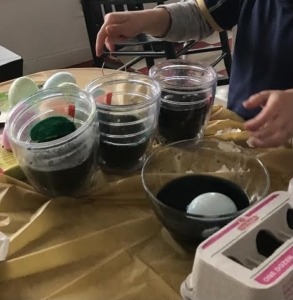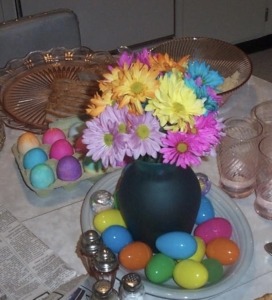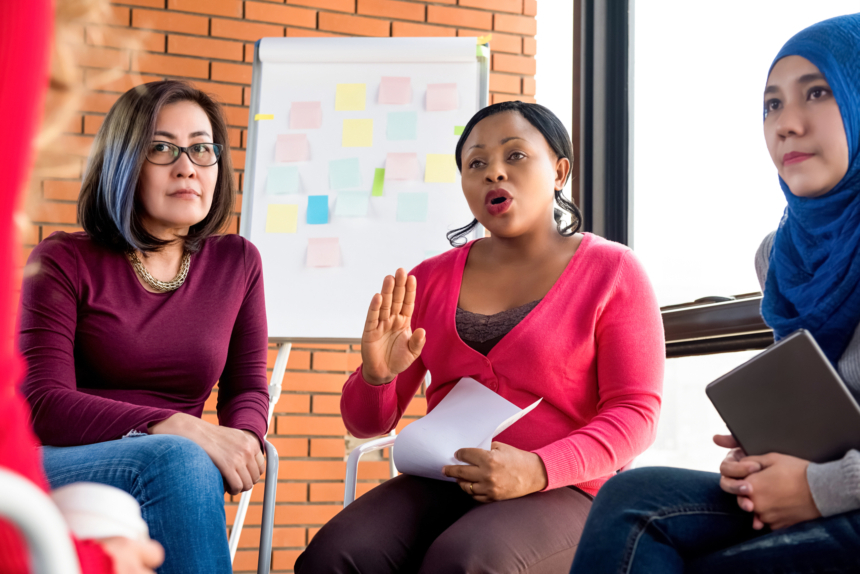Every family celebrates Easter in their own way, but for mum Karin, it always reminds her of childhood in the United States and, in particular, the tradition of egg dyeing. Here she tells us in the UK a little about this common US activity and outlines how you can give it a go yourself with your family.
When I was very young, my Dad always made a big production of any special occasion. From Easter to Valentine’s Day to the 4th of July, my Dad was always making an effort to ensure that no holiday went without the appropriate amount of celebration. In the US holidays often centre around religious festivals such as Lent, Easter and Christmas but usually focus on the aspects that aren’t specifically about faith, so when it came to Easter, the focus was on Easter baskets, chocolate and dyeing Easter eggs for the annual egg hunt.

I know that people decorate eggs in the UK but dyeing them seems less common here than in the US. In my case, my home state was settled by a lot of European immigrants and I believe the tradition of dyeing and decorating eggs began around then… so let me tell you a little bit about how it works 200+ years later.
Our Easter preparations would begin usually no earlier than Good Friday or on the Saturday before Easter, when my Dad would buy two dozen or more eggs in preparation for the big dye-fest. In the US, egg dyeing is so popular that there is a company that produces egg dyeing kits that include small tablets (about the size of a paracetamol tablet) of dried dye. The colours are always quite vibrant – red, blue, green, orange, yellow, pink and purple – and you place a single colour tablet into a cup or bowl, add the required amounts of vinegar and water to the cup and watch the dye tablet dissolve in the liquid. All of which results in a liquid dye in which to dye your egg.
In our family we would hard-boil the eggs in advance and allow them to cool sufficiently. For some reason, when I was growing up, the eggs in the US always had a white shell and I had never seen a brown egg until I moved to the UK. Obviously, white shelled eggs were far easier to dye and resulted in a much brighter dye to the shell but it does still work on brown eggs – although it’s not quite as vibrant.
“It helps us to feel like we’re keeping in touch, and it’s so fun to be able to share this tradition from my childhood in the US.”
With a minimum of 24 hard-boiled eggs on the table, my Dad would set up the supplies for our egg dyeing… He would cover the table in newspaper to prevent us from marking the table and would also set out lots of paper towels to be able to blot the eggs after they were removed from the dye. With a dry, cooled white-shelled egg, we would then take a wax crayon (white works best) and draw some designs, shapes, words, names or whatever took our fancy onto the egg prior to dipping the egg in dye.
Once your design work was finished, you would choose which dye cup in which to place your egg. If you wanted a multi-coloured egg, you’d choose one colour and hold your egg partially submerged in the colour for several minutes, remove it, blot off the excess liquid and then repeat the process in a second or third colour. This required a bit of finesse and patience but the resulting egg colour was generally worth it.
The longer you left the egg in the dye, the more vibrant the result… and the wax crayon drawings would remain undyed and thus would “pop” off the egg as the perfect decoration. The egg dyeing kits usually also contained stickers or paper egg cups in which to display and/or decorate your egg after it was dyed and, to this day, the smell of vinegar takes me immediately back to those childhood years.
 After the eggs were dyed, my Dad would gather all of them into one basket and we wouldn’t see them again until Easter Sunday morning when he would spend a significant amount of time hiding 24+ eggs around the garden for my brother and I to find. We always had to be sure to know how many we were looking for as there was undoubtedly at least one which never was found! Once the eggs were reclaimed into our individual baskets, we were also treated to a scavenger hunt to find our own Easter baskets which contained chocolate bunnies and eggs, jelly beans, marshmallow chicks and bunnies and various small presents like sunglasses, notepads and stickers. Our Easter basket sweeties and chocolates lasted for weeks while the dyed hard-boiled eggs were popped into the fridge to serve as lunch and breakfast items for the next week or so. It was always an adventure having a brightly-coloured hardboiled egg to unwrap at lunchtime!.
After the eggs were dyed, my Dad would gather all of them into one basket and we wouldn’t see them again until Easter Sunday morning when he would spend a significant amount of time hiding 24+ eggs around the garden for my brother and I to find. We always had to be sure to know how many we were looking for as there was undoubtedly at least one which never was found! Once the eggs were reclaimed into our individual baskets, we were also treated to a scavenger hunt to find our own Easter baskets which contained chocolate bunnies and eggs, jelly beans, marshmallow chicks and bunnies and various small presents like sunglasses, notepads and stickers. Our Easter basket sweeties and chocolates lasted for weeks while the dyed hard-boiled eggs were popped into the fridge to serve as lunch and breakfast items for the next week or so. It was always an adventure having a brightly-coloured hardboiled egg to unwrap at lunchtime!.
If you’re interested in trying this with your family then using liquid food colouring/dye in a vinegar and water solution would work just as well. You can also create dyes from foods like beetroot or red onion. White shelled eggs take the dye easier but it does work on brown eggs as well and another option would be to use permanent markers, acrylic paint or stickers/jewels/googly eyes to decorate your eggs. I would recommend hard-boiling the eggs to prevent any messy accidents if an egg is dropped during the decorating process. Of course, if you will be eating the eggs after decorating, ensure that no paint or decoration comes off onto the unshelled eggs for safety purposes.
This tradition was one that I tried to keep up with my own, English husband after we were first married and, now that we have children of our own, we have done this with them as well. My US family still send me the egg-dyeing kits to facilitate the process, which helps us to feel like we’re keeping in touch, and it’s so fun to be able to share this tradition from my childhood in the US.
Do you have any Easter traditions in your family? Share them with us over on our social media channels Facebook, Twitter and Instagram.


 After the eggs were dyed, my Dad would gather all of them into one basket and we wouldn’t see them again until Easter Sunday morning when he would spend a significant amount of time hiding 24+ eggs around the garden for my brother and I to find. We always had to be sure to know how many we were looking for as there was undoubtedly at least one which never was found! Once the eggs were reclaimed into our individual baskets, we were also treated to a scavenger hunt to find our own Easter baskets which contained chocolate bunnies and eggs, jelly beans, marshmallow chicks and bunnies and various small presents like sunglasses, notepads and stickers. Our Easter basket sweeties and chocolates lasted for weeks while the dyed hard-boiled eggs were popped into the fridge to serve as lunch and breakfast items for the next week or so. It was always an adventure having a brightly-coloured hardboiled egg to unwrap at lunchtime!.
After the eggs were dyed, my Dad would gather all of them into one basket and we wouldn’t see them again until Easter Sunday morning when he would spend a significant amount of time hiding 24+ eggs around the garden for my brother and I to find. We always had to be sure to know how many we were looking for as there was undoubtedly at least one which never was found! Once the eggs were reclaimed into our individual baskets, we were also treated to a scavenger hunt to find our own Easter baskets which contained chocolate bunnies and eggs, jelly beans, marshmallow chicks and bunnies and various small presents like sunglasses, notepads and stickers. Our Easter basket sweeties and chocolates lasted for weeks while the dyed hard-boiled eggs were popped into the fridge to serve as lunch and breakfast items for the next week or so. It was always an adventure having a brightly-coloured hardboiled egg to unwrap at lunchtime!.





